A New Non-Destructive TDR System Combined with a Piezoelectric Stack for Measuring Properties of Geomaterials
Abstract
:1. Introduction
2. Measuring Methods
2.1. Measuring Water Content and Dry Density
2.1.1. Sand Cone Test
2.1.2. TDR Technique
- (1)
- TDR Instrument
- (2)
- Measuring Water Content and Dry Density of Soil by Using the TDR System
2.2. Measuring Modulus of Elasticity
2.2.1. SASW Method (Spectral Analysis of Surface Waves Method)
2.2.2. RPLT (Repetitive Plate Load Test)
2.2.3. LFWD (Light Falling Weight Deflectometer)
3. Development of a New TDR System
3.1. Development of Flat Type Probe
3.2. Combining Flat Type Probe with Piezoelectric Stack
4. Discussions of the Test Results
4.1. Results of Water Contents and Dry Density
4.2. Results of Modulus of Elasticity
5. Conclusions
- A new non-destructive TDR system, capable of measuring the dry density, water content, and elastic modulus has been developed. While the conventional TDR system requires inserting a probe into the ground to measure the soil’s dry density and the water content, the new non-destructive TDR system developed in this study can measure these parameters on the surface of the compacted soil. Based on the test results on standard sand in Korea, the dry density and water content measured by the new TDR system with a flat type probe are in good agreement with those measured by the standard test. This indicates that the new TDR system is feasible and can lead to time and cost savings in measuring dry density and water content.
- Based on the test results on different types of materials such as asphalt, concrete, and soil, a clear difference in the elastic moduli for the tested materials was observed. This implies that the new TDR system can be used as a tool to measure the stiffness of soil. A further study on developing the correlation between the moduli measured by the new TDR and those by LFWD will be useful.
- This new non-destructive TDR system is an innovative TDR system that can enable the measurement of moisture content and dry density as well as elastic modulus on the surface of compacted soil. This system will be useful for advancing the compaction quality of soil after it is reinforced with numerous test data on a variety of types of soils. This can be accomplished in further study.
Acknowledgments
Author Contributions
Conflicts of Interest
References
- Fellner-Fedegg, H. The Measurement of dielectrics in the time domain. J. Phys. Chem. 1969, 73, 616–623. [Google Scholar] [CrossRef]
- Topp, G.C.; Davis, J.L.; Annan, A.P. Electromagnetic determination of soil water content: Measurements in coaxial transmission lines. Water Resour. Res. 1980, 16, 574–582. [Google Scholar] [CrossRef]
- Roth, C.H.; Malicki, M.A.; Plagge, R. Empirical evaluation of the relationship between soil dielectric permittivityand volumetric water content as the basis for calibrating soil moisture measurements by TDR. J. Soil Sci. 1992, 43, 1–13. [Google Scholar] [CrossRef]
- Dirksen, C.; Dasberg, S. Improved calibration of Time Domain Reflectometry soil water content measurements. Soil Sci. Soc. Am. J. 1993, 57, 660–667. [Google Scholar] [CrossRef]
- Malicki, M.A.; Plagge, R.; Roth, C.H. Improving the calibration of dielectric TDR soil moisture determination taking into account the solid soil. Eur. J. Soil Sci. 1996, 47, 357–366. [Google Scholar] [CrossRef]
- Siddiqui, S.I.; Drnvich, V.P. Use of Time Domain Reflectometry for Determination of Water Content and Density of Soil; FHWA/IN/JHRP-95-9; Purdue University: West Lafayette, IN, USA, 1995. [Google Scholar]
- Sallam, A.M.; White, N.K.; Ashmawy, A.K. Evaluation of the Purdue TDR Method for Soil Water Content and Density Measurement; Final Report the Florida Department of Transportation, Contract No. BC-353-30; Transportation Research Board: Tallahassee, FL, USA, 2004. [Google Scholar]
- Yu, X.; Drnevich, V.P. Soil water content and dry density by Time Domain Reflectometry. J. Geotech. Geoenviron. Eng. 2004, 130, 922–934. [Google Scholar] [CrossRef]
- Thring, L.M.; Boddice, D.; Metje, N.; Curioni, G.; Chapman, D.N.; Pring, L. Factors affecting soil permittivity and proposals to obtain gravimetric water content from time domain reflectometry measurements. Can. Geotech. J. 2014, 51, 1303–1317. [Google Scholar] [CrossRef]
- Ochsner, T.E.; Horton, R.; Ren, T. Simultaneous water content, air-filled porosity, and bulk density measurements with thermo-time domain reflectometry. Soil Sci. Soc. Am. J. 2001, 65, 1618–1622. [Google Scholar] [CrossRef]
- Liu, X.; Ren, T.; Horton, R. Determination of soil bulk density with thermo-time domain reflectometry sensors. Soil Sci. Soc. Am. J. 2008, 72, 1000–1005. [Google Scholar] [CrossRef]
- Liu, X.; Lu, S.; Horton, R.; Ren, T. In situ monitoring of soil bulk density with a thermo-TDR sensor. Soil Sci. Soc. Am. J. 2014, 78, 400–407. [Google Scholar] [CrossRef]
- Ren, T.; Noborio, K.; Horton, R. Measuring soil water content, electrical conductivity, and thermal properties with a thermo-time domain reflectometry probe. Soil Sci. Soc. Am. J. 1999, 63, 450–457. [Google Scholar] [CrossRef]
- Shirley, D.J.; Hampton, L.D. Shear wave measurements in laboratory sediments. J. Acoust. Soc. Am. 1978, 63, 607–613. [Google Scholar] [CrossRef]
- Dyvik, R.; Madshus, C. Laboratory Measurements of Gmax Using Bender Element; Engineering Convention, Detroit; American Society of Civil Engineers: New York, NY, USA, 1985; pp. 186–196. [Google Scholar]
- Choi, C.; Park, C.; Lee, I.; Kim, D. Application of in-situ testing methods for bearing capacity estimation of railroad roadbed. In Proceedings of the Korean Geotechnical Society Conference, Daegu, Korea, 24–26 March 2006.
- Park, J.O.; Kim, H.K.; Jeon, I.S. Evaluation of subgrade state in the gyeongbu high speed railway through GPR tests and drilling boreholes. In Proceedings of the 2009 Spring Conference of Korean Society for Railway, Gyeongju, Korea, 21–23 May 2009; pp. 984–996.
- Das, B.M. Principles of Geotechnical Engineering, 6th ed.; Thomson: Toronto, ON, Canada, 2006. [Google Scholar]
- Campbell Scientific Product Brochures, TDR100 Time-Domain Reflectometer. Available online: http://www.campbellsci.com/tdr100 (accessed on 1 June 2016).
- Drnevich, V.; Yu, X.; Lovell, J. Beta Testing Implementation of the Purdue Time Domain Reflectometry (TDR) Method for Soil Water Content and Density Measurement; Indiana Department of Transportation and Purdue University: West Lafayette, IN, USA, 2003. [Google Scholar]
- Zambrano, C.E. Soil Type Identification Using Time Domain Reflectometry. Master’s Thesis, Purdue University, West Lafayette, IN, USA, 2006. [Google Scholar]
- Giese, K.; Tiemann, R. Determination of the complex permittivity from thin-sample time domain reflectometry improved analysis of the step response waveform. Adv. Mol. Relax. Process. 1975, 7, 45–59. [Google Scholar] [CrossRef]
- Standard Test Method for Water Content and Density of Soil in Place by Time Domain Reflectometry (TDR); ASTM D 6780-05; ASTM: West Conshohocken, PA, USA, 2005.
- Stokoe, K.H.; Wright, S.G.; Bay, J.A.; Roesset, J.M. Characterization of geotechnical sites by SASW method. Tech. Rev. Geophys. Charact. Sites 1994, 10, 15–25. [Google Scholar]
- Choi, C.Y.; Lee, S.H.; Bae, J.H.; Park, D.H. Evaluation of correlation between Strain modulus (Ev2) and Deformation modulus (E LFWD) using cyclic plate loading test and LFWD. J. Korean Geosynth. Soc. 2011, 10, 33–41. [Google Scholar]
- Kang, H.B.; Kim, K.J.; Kang, J.T.; Kim, J.R. A Study on the estimation of relative compaction on the subgrade using a Portable FWD. J. Korea Inst. Struct. Maint. Insp. 2007, 11, 213–219. [Google Scholar]
- Knight, J.H.; Ferré, P.A.; Rudolph, D.L.; Kachanoski, R.G. A numerical analysis of the effects of coatings and gaps upon relative dielectric permittivity measurement with time domain reflectometry. Water Resour. Res. 1997, 33, 1455–1460. [Google Scholar] [CrossRef]
- Ferré, P.A.; Knight, J.H.; Rudolph, D.L.; Kachanoski, R.G. The sample areas of conventional and alternative time domain reflectometry probes. Water Res. Res. 1998, 34, 2971–2979. [Google Scholar] [CrossRef]
- Piezo System Inc. Large Piezo Stack. Available online: http://www.piezo.com/prodstacks1.html (accessed on 1 June 2016).
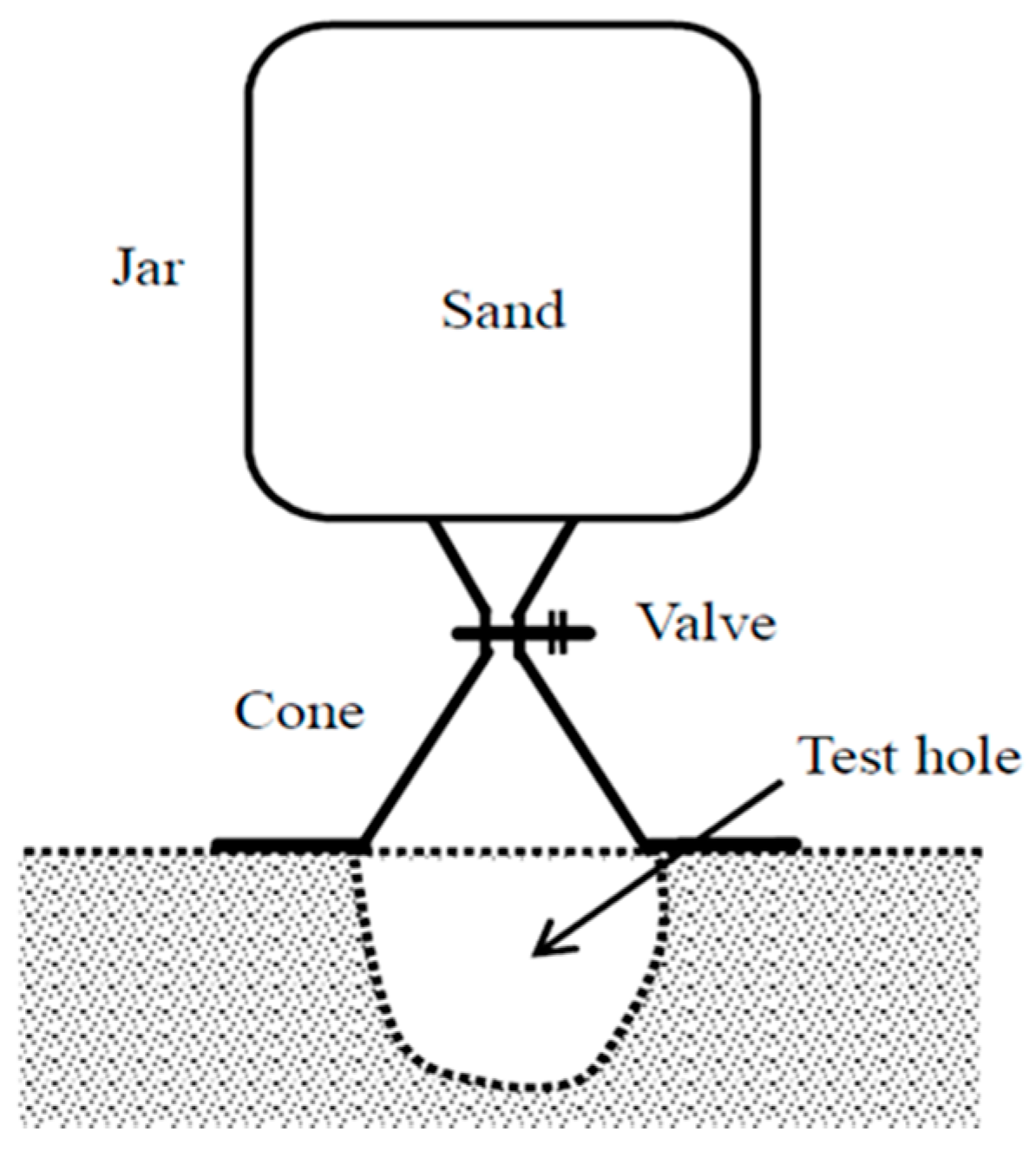
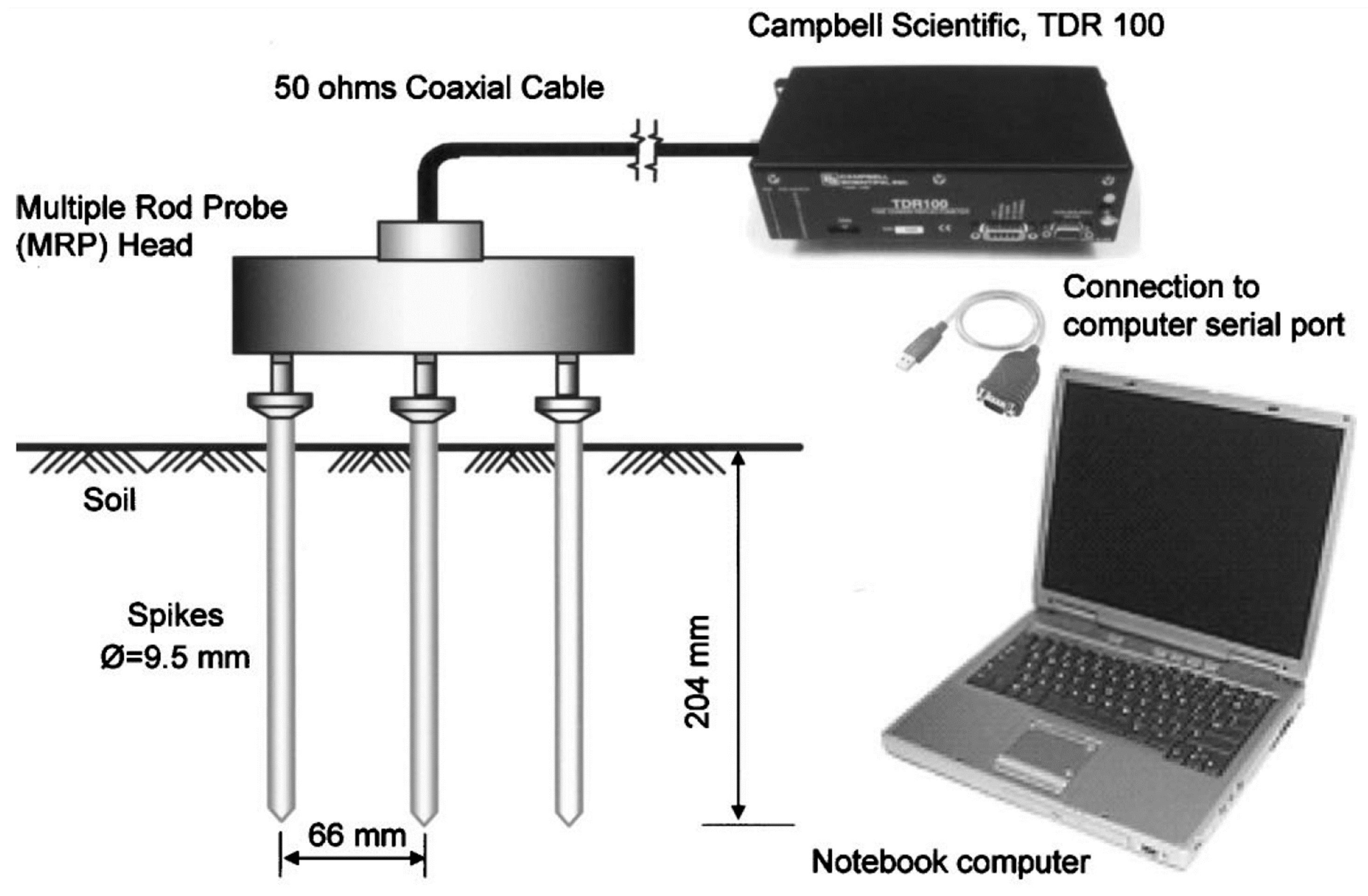
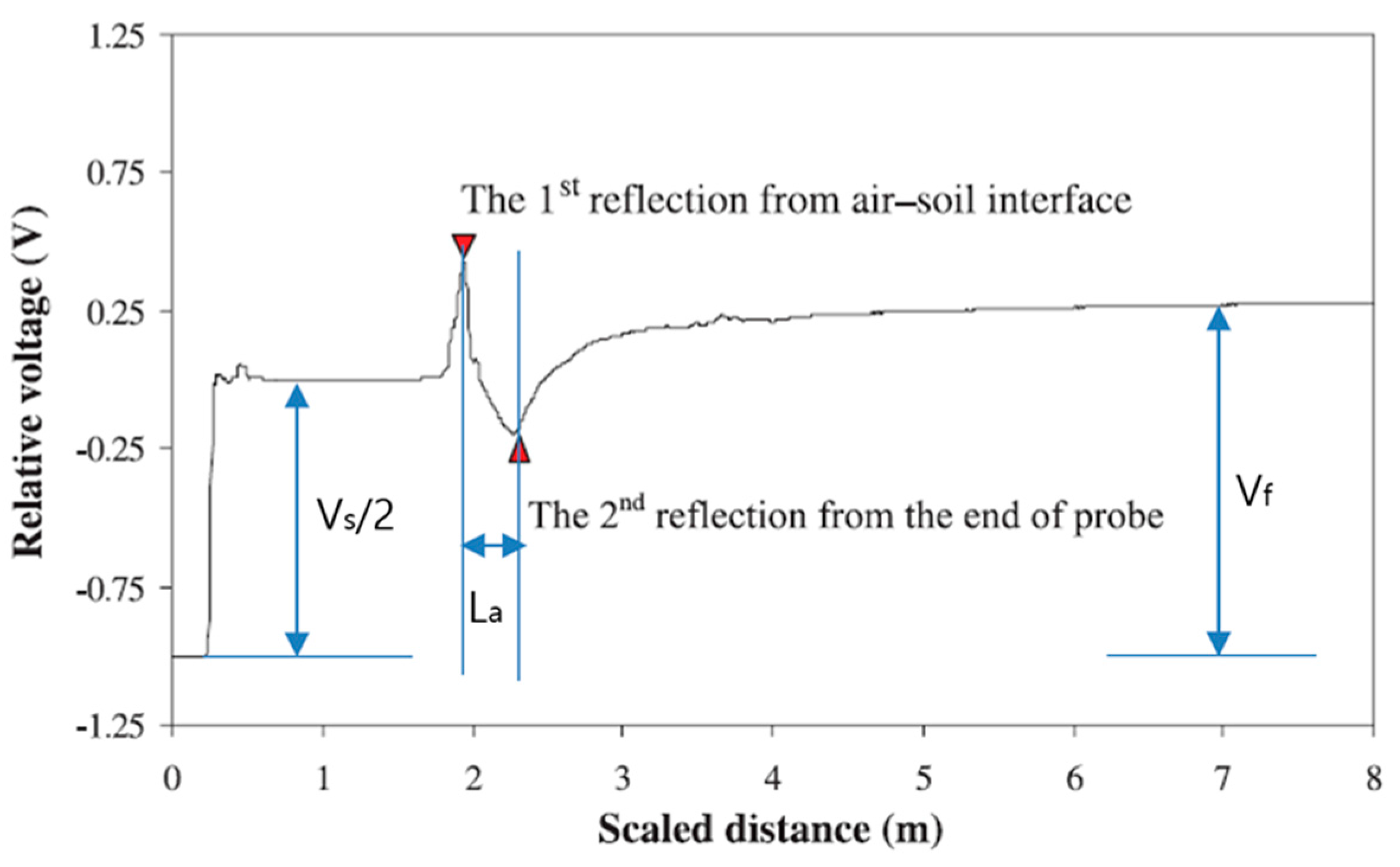

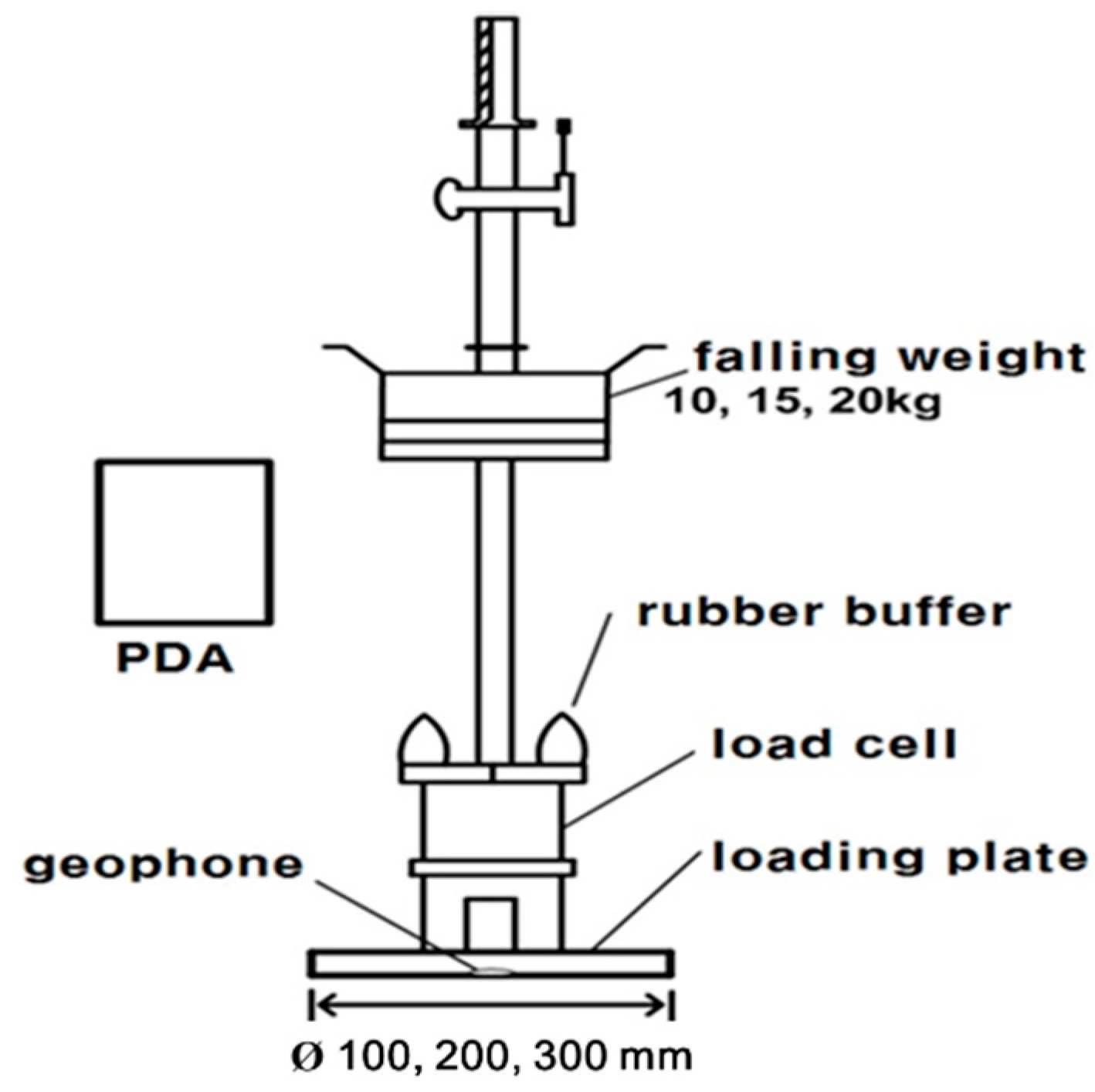
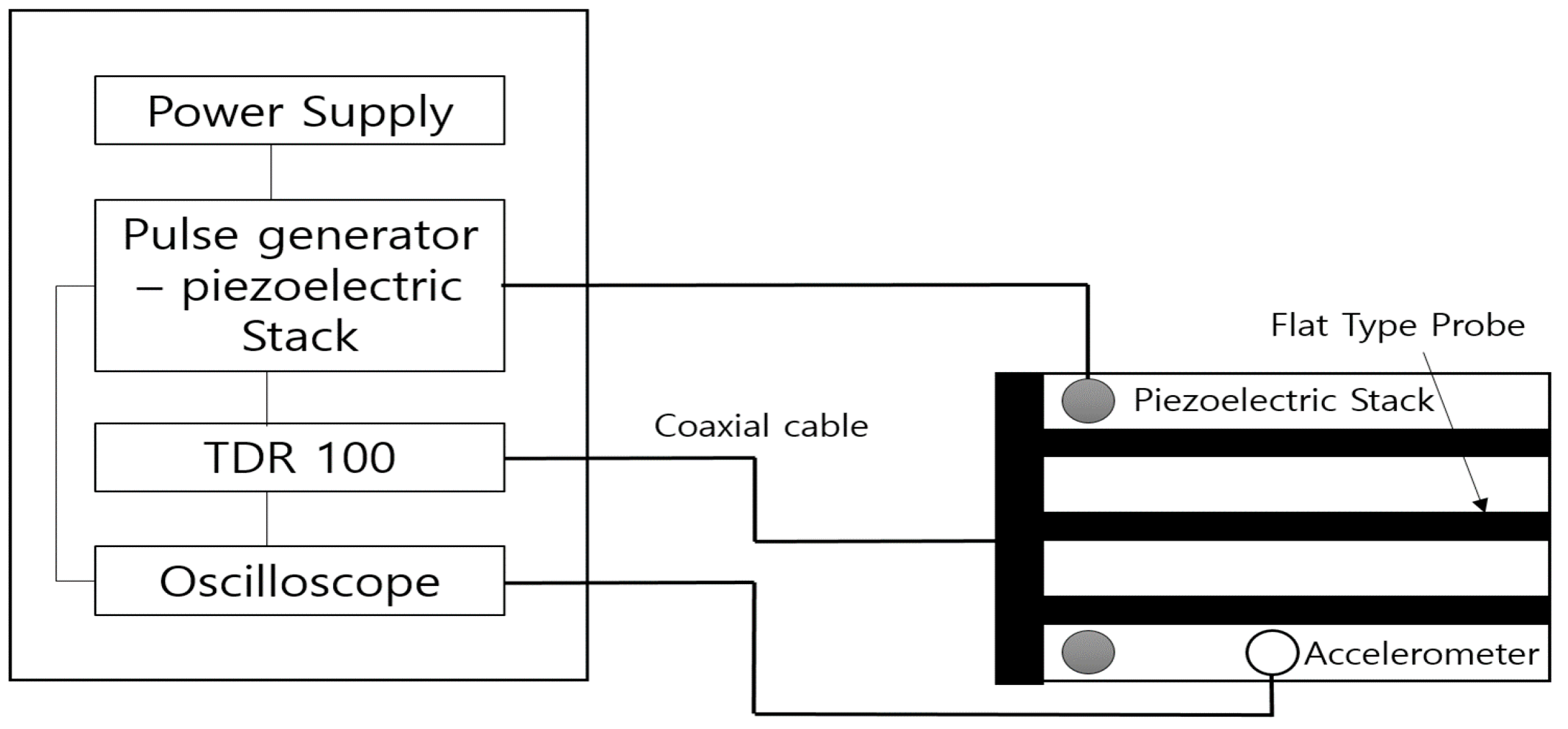
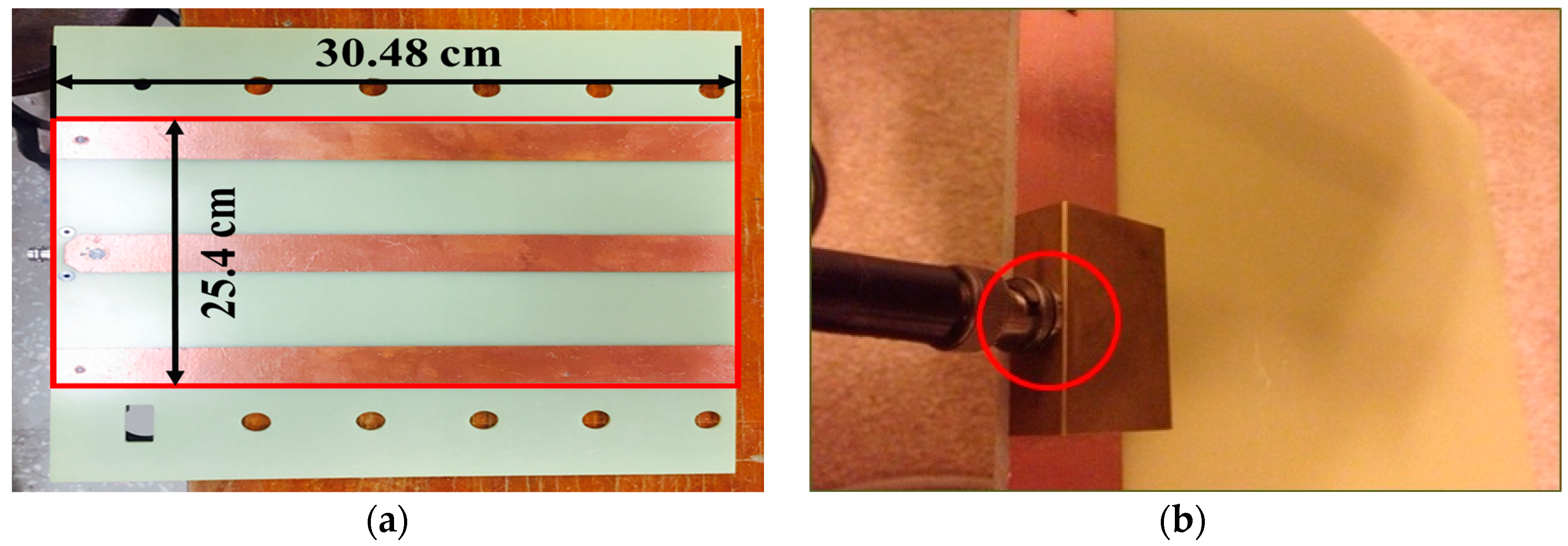

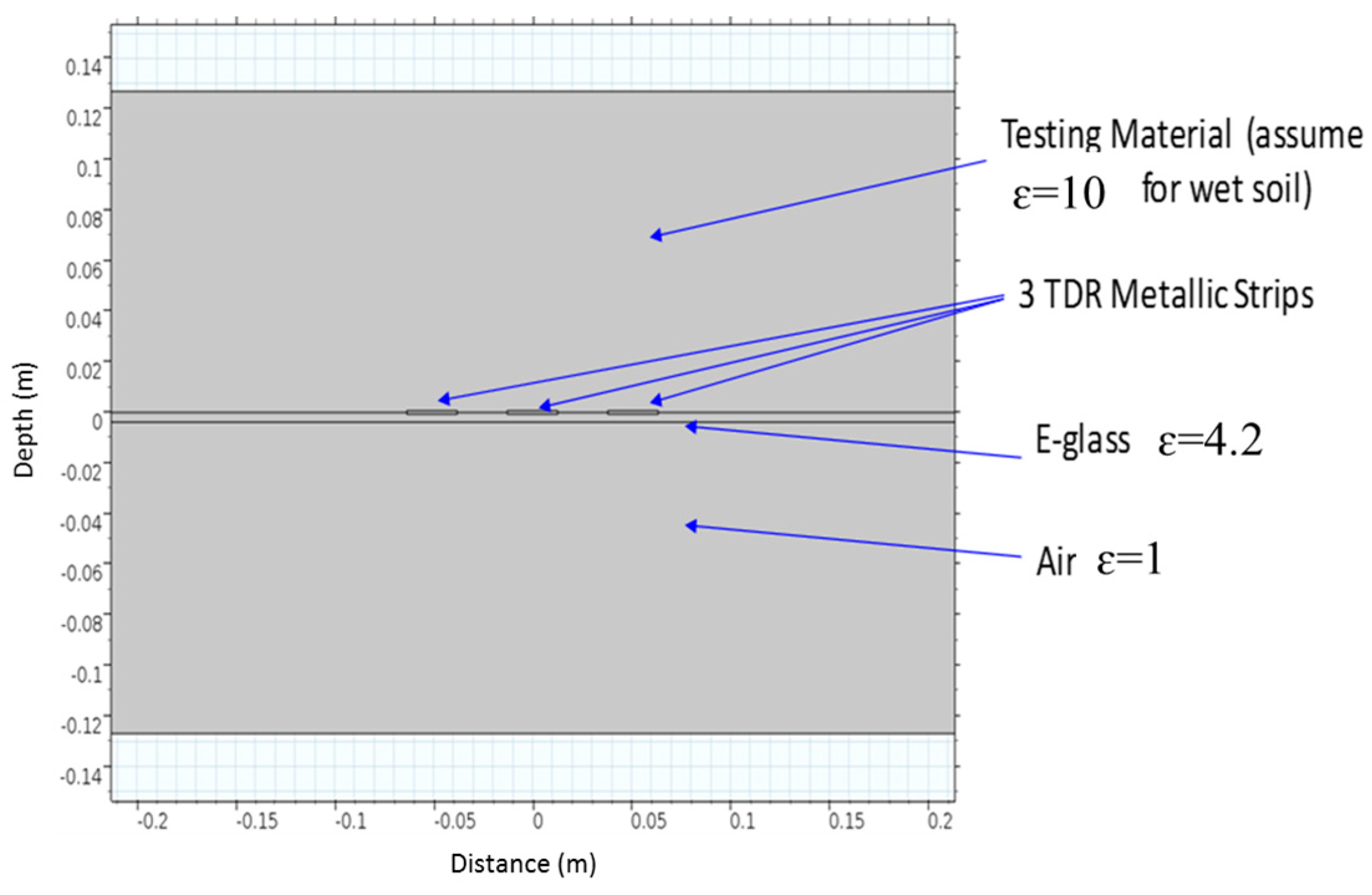
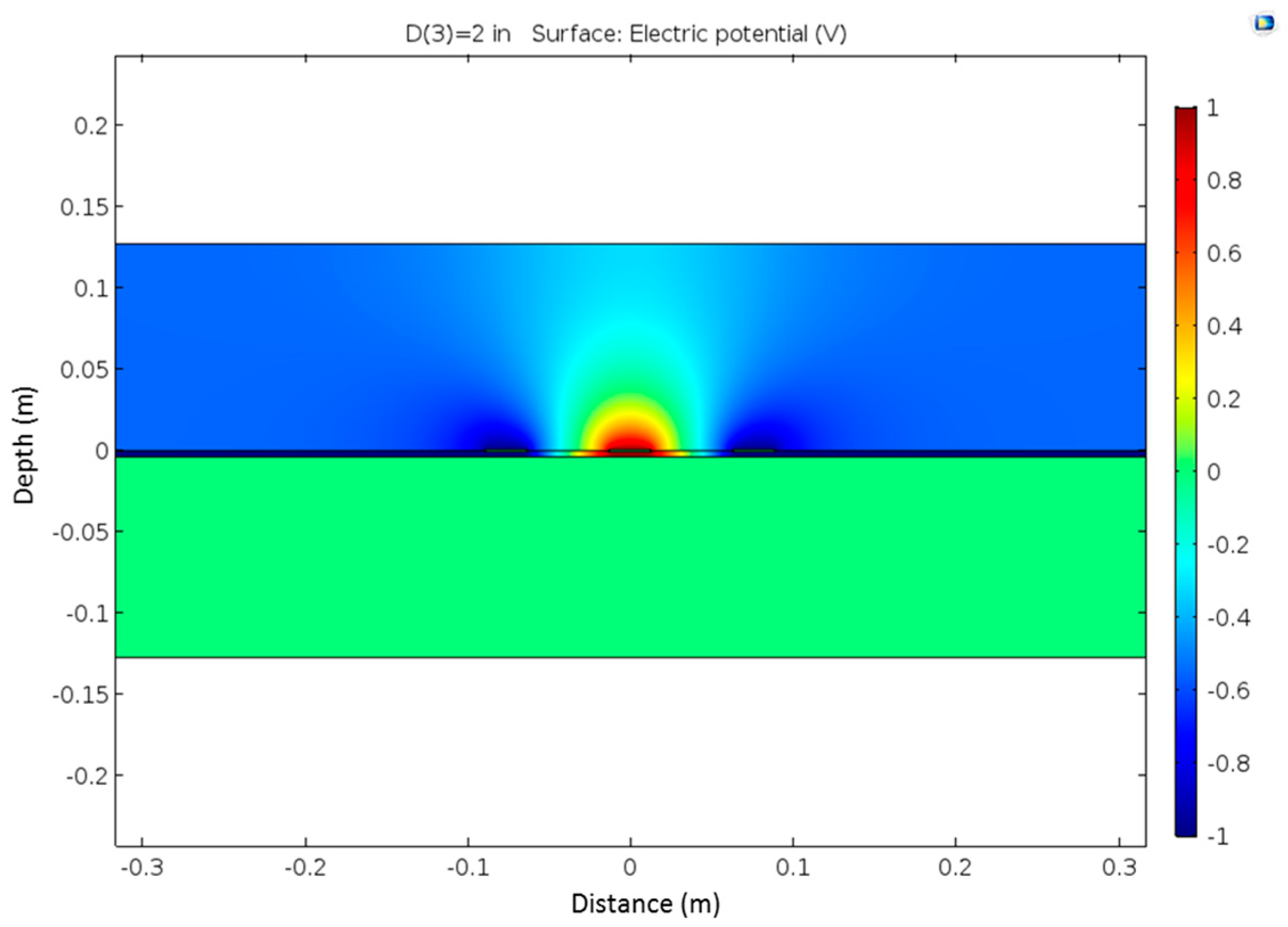
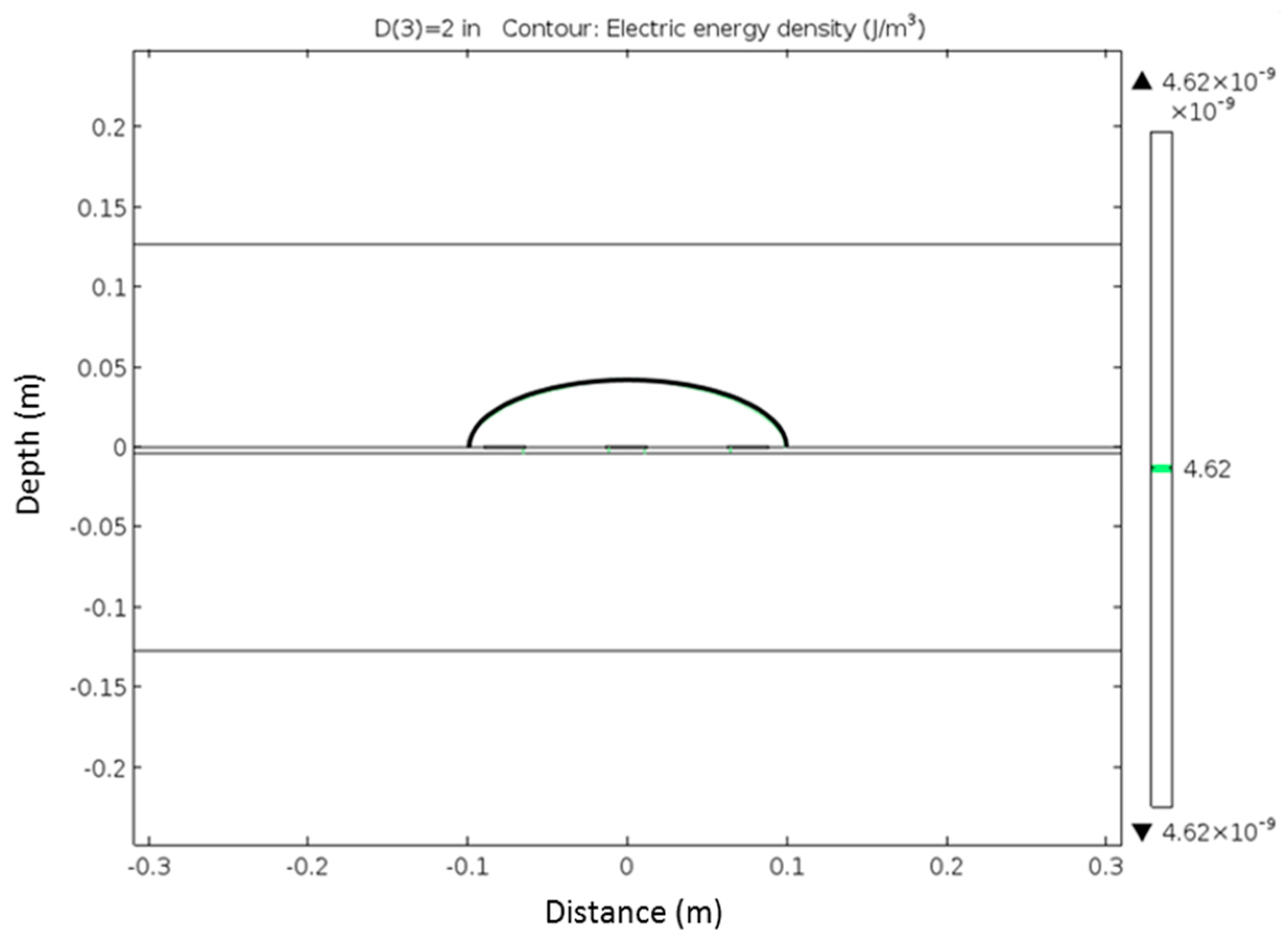
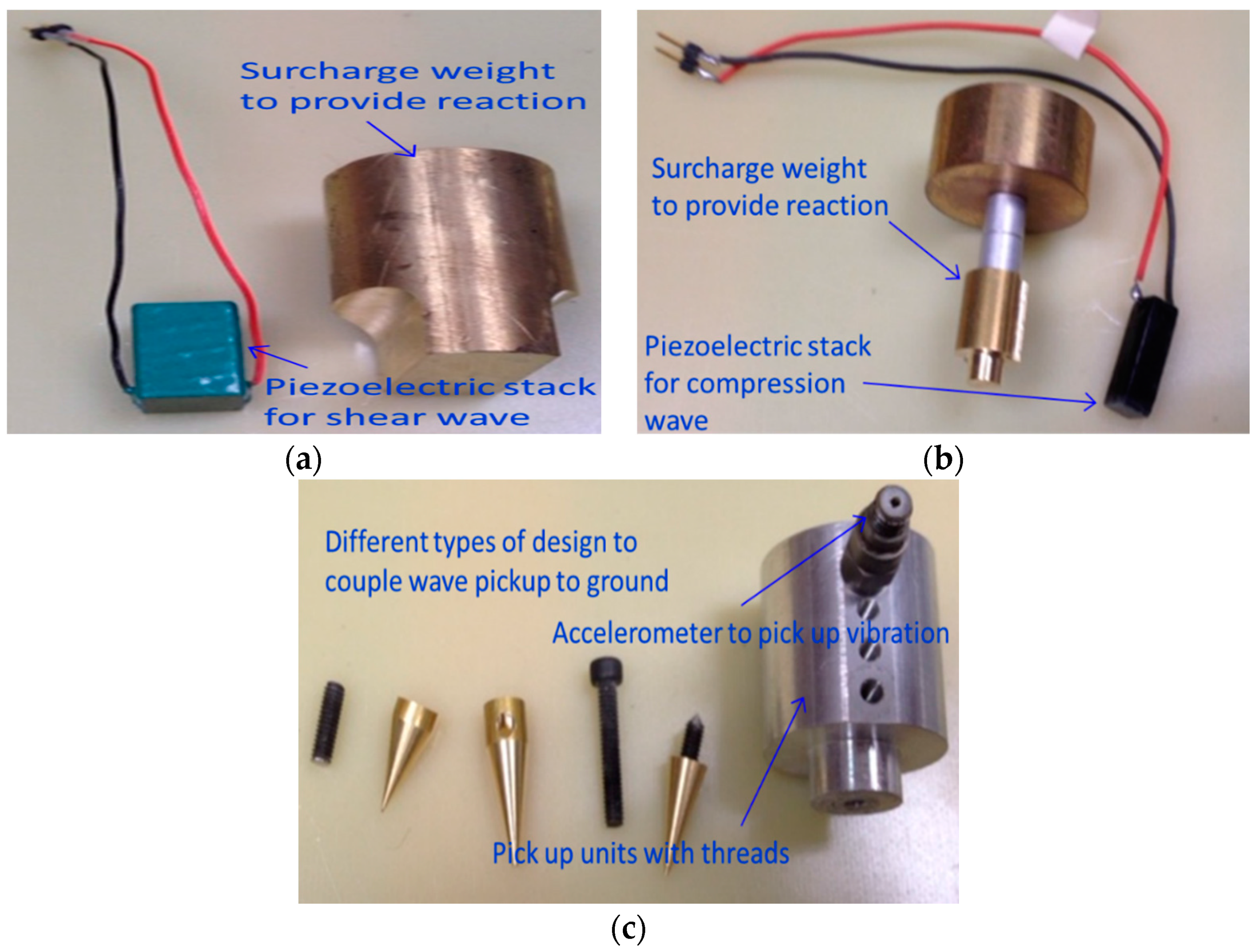
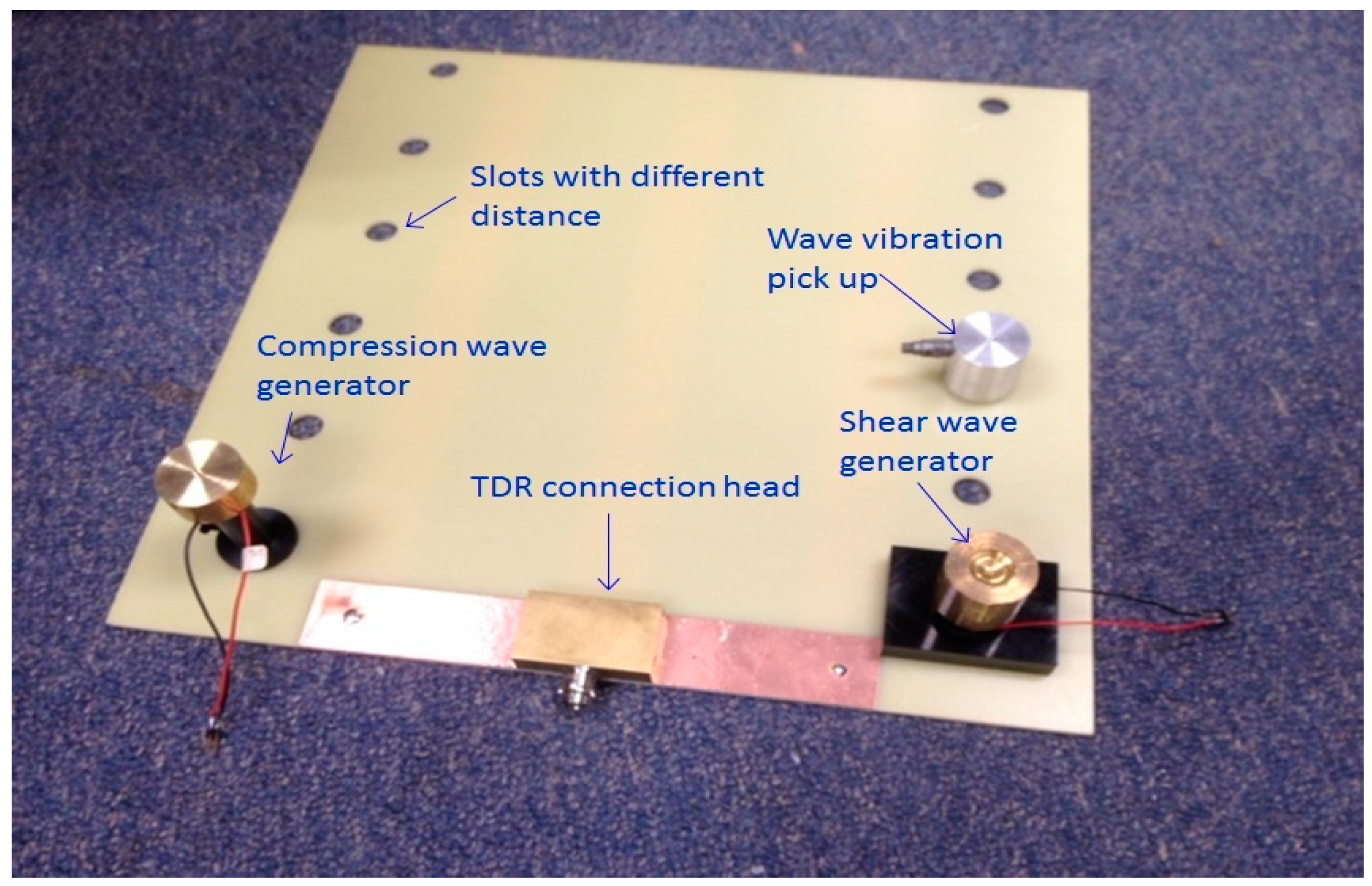
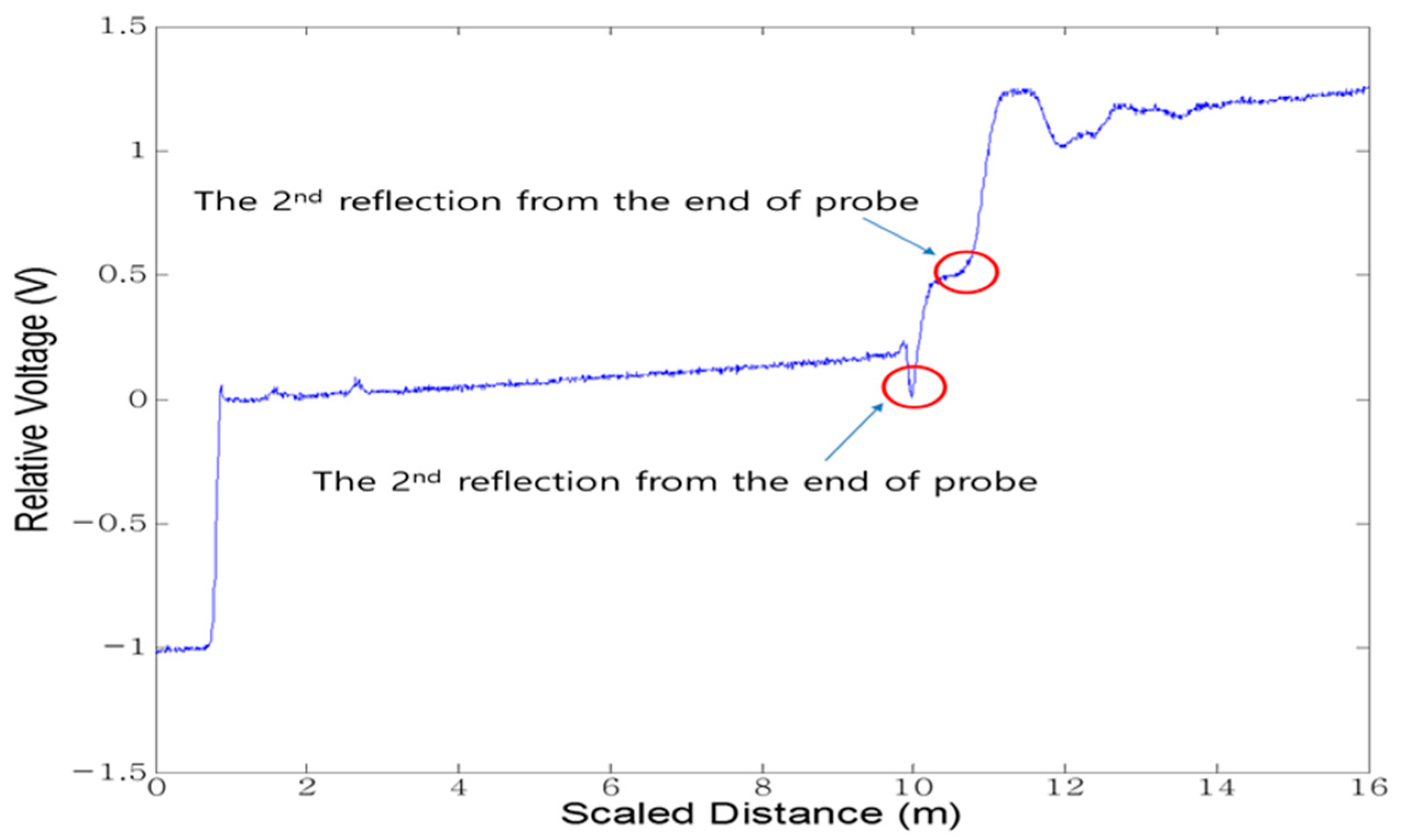


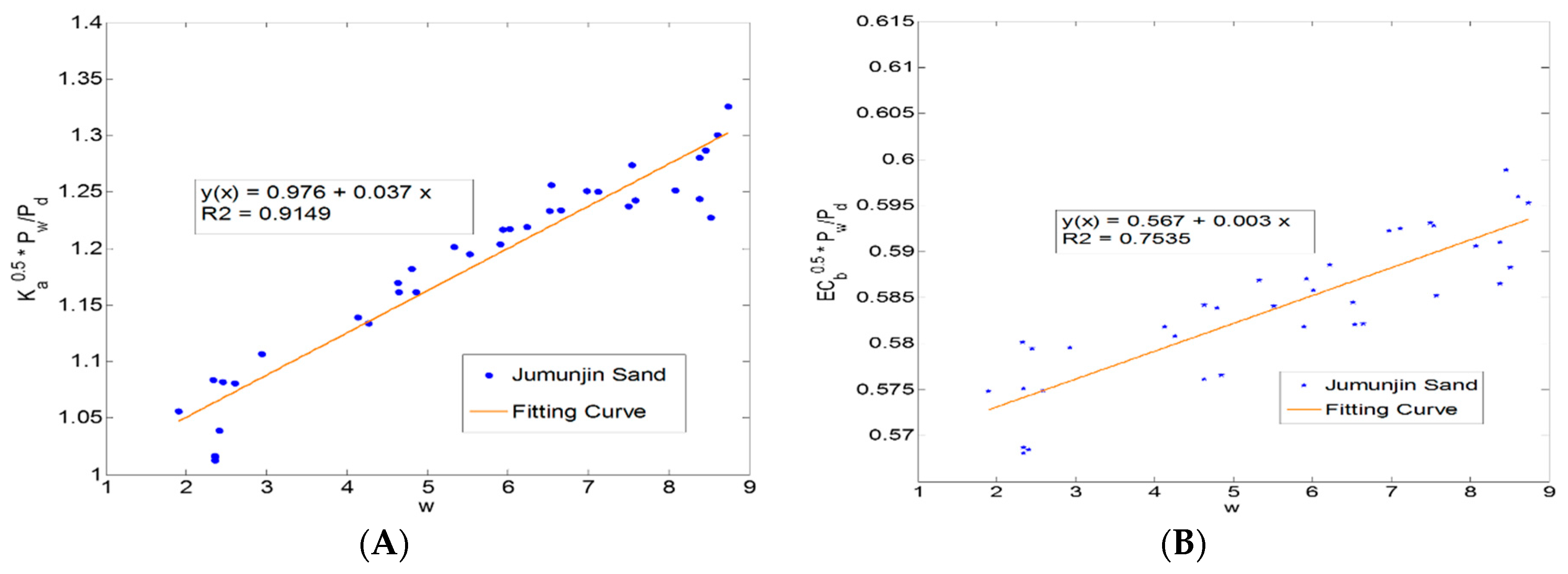
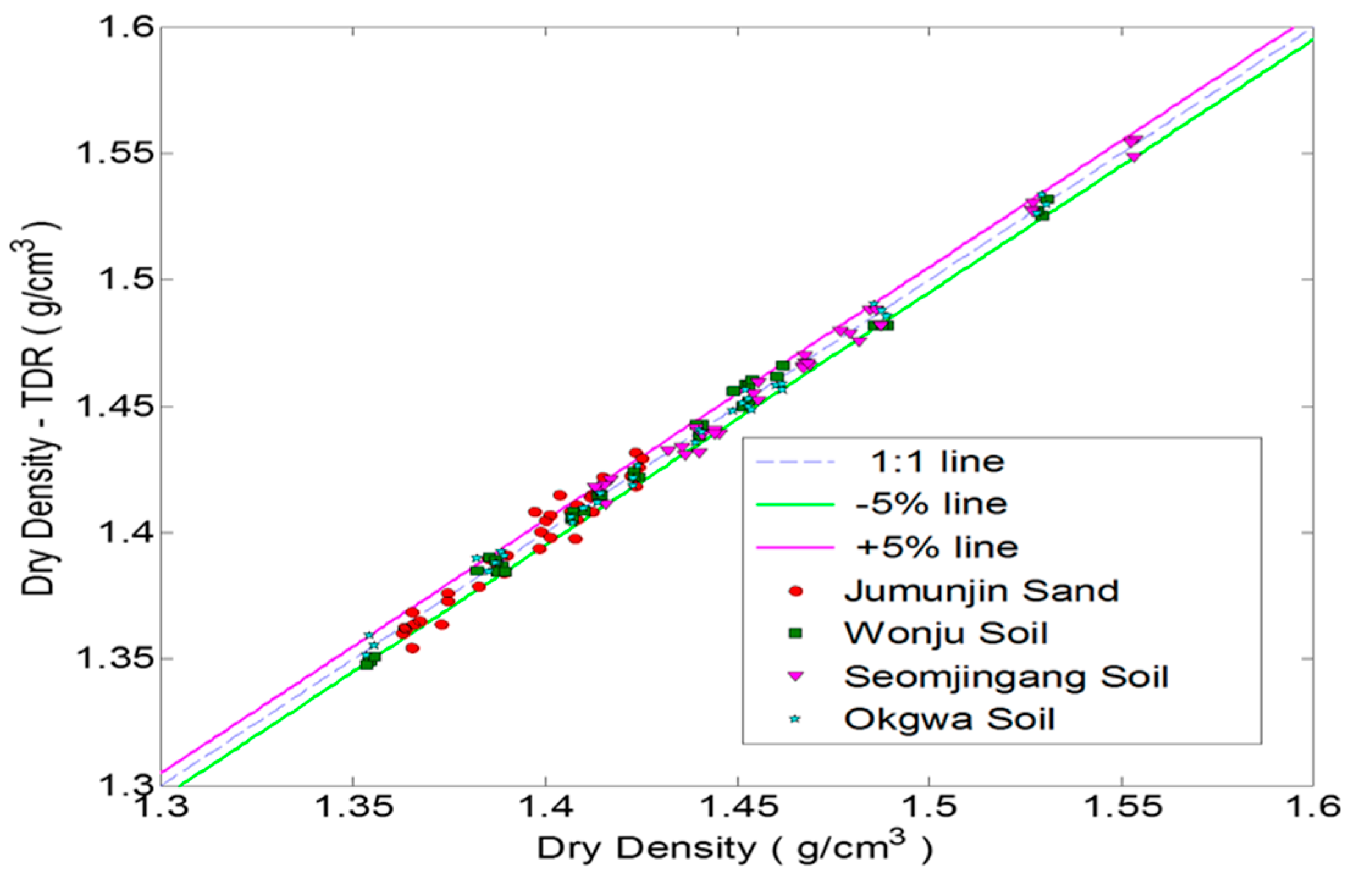


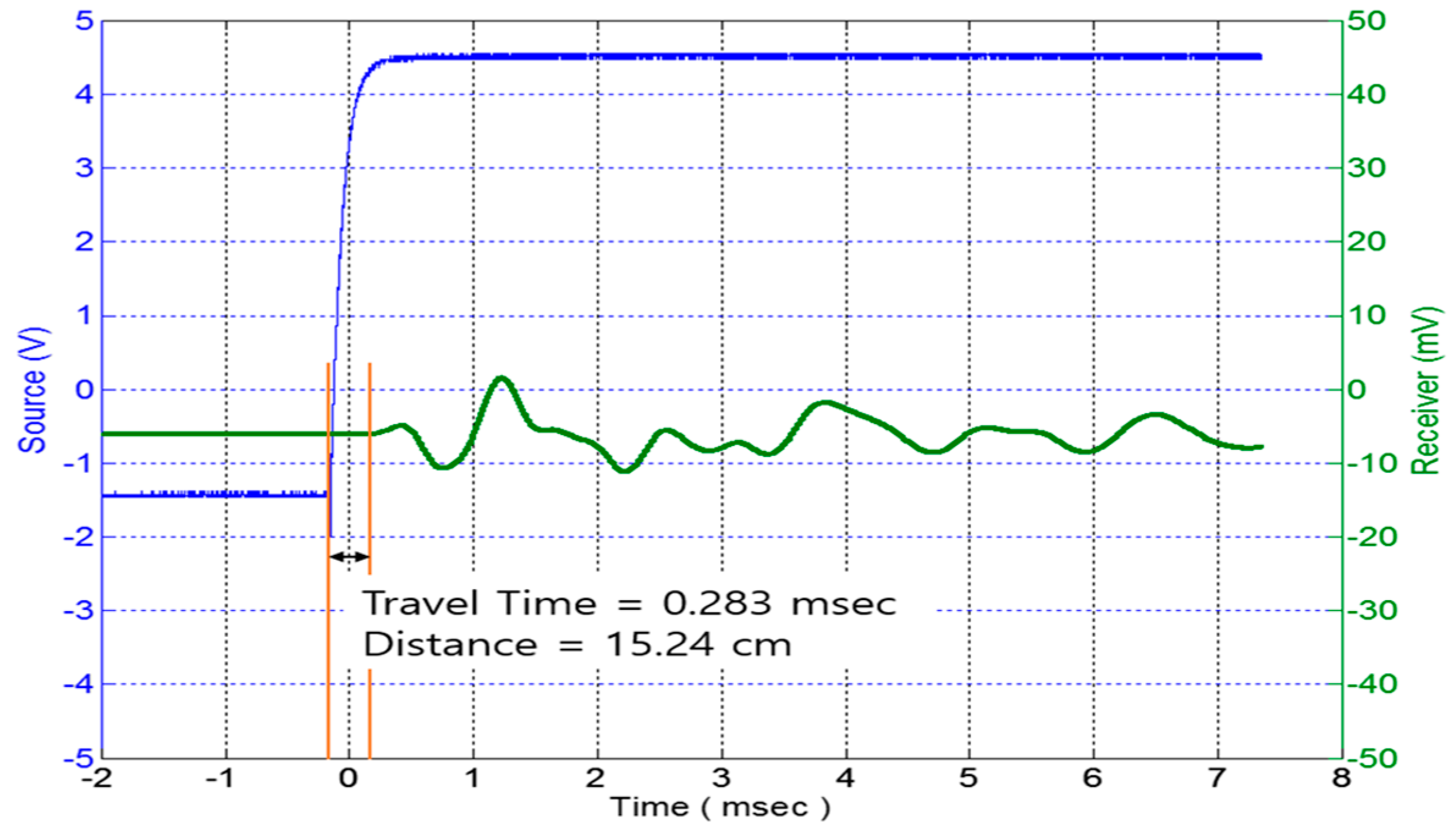
| Campbell Scientific Pulse Generator/Sampler | |
|---|---|
| Input signal type | Step rise |
| System rise time | <250 ps |
| Time resolution | 12.2 ps |
| Bandwidth | 1.7 GHz |
| Output impedance | 50 ± 1 ohms |
| Noise filtering | 1 to 128 average |
| Temperature range | −40 to 55 °C |
| Dimension | 236 mm × 126 mm × 59 mm |
| Piezoelectric Stack | |
|---|---|
| Compressive Strength | 8.8 × 108 N/m2 |
| Tensile Strength | 4.4 × 106 N/m2 |
| Young’s Modulus | 4.4 × 1010 N/m2 |
| Poisson’s Ration | 0.34 |
| Density | 7900 Kg/m3 |
| Wires | Red positive, Black negative |
| Thermal Operation Range | −20 to 80 °C |
| Thermal Storage Range | −30 to 85 °C |
| Humidity | <50% |
| Soil | Classification | Sand (%) | Silt (%) | Clay (%) | Gs | P < No. 200 (%) | Liquid Limit (%) | Plastic Index |
|---|---|---|---|---|---|---|---|---|
| Jumunjin Sand | SP | 100 | 0 | 0 | 2.65 | 0 | - | - |
| Wonju Soil | SM | 80 | 17 | 3 | 2.58 | 20 | - | - |
| Seomjingang Soil | SP | 95 | 4 | 1 | 2.64 | 5 | - | - |
| Okgwa Soil | SM | 78 | 16 | 2 | 2.60 | 18 | - | - |
| Asphalt | |||||
| Wave Type | Distance (cm) | Signal Start (us) | Signal Arrival (us) | Wave Speed (m/s) | Modulus of Elasticity (MPa) |
| Compression Wave | 6.5 | 0 | 53.01 | 1226.2 | 3758.92 |
| Shear Wave | 6.5 | 0 | 102.02 | 637.1 | 1014.74 |
| Concrete | |||||
| Wave Type | Distance (cm) | Signal Start (us) | Signal Arrival (us) | Wave Speed (m/s) | Modulus of Elasticity (MPa) |
| Compression Wave | 10 | 0 | 48.02 | 2082.5 | 8673.61 |
| Shear Wave | 10 | 0 | 128.6 | 777.6 | 1209.32 |
| Soil | |||||
| Wave Type | Distance (cm) | Signal Start (us) | Signal Arrival (us) | Wave Speed (m/s) | Modulus of Elasticity (MPa) |
| Compression Wave | 15 | 0 | 283 | 530.03 | 421.40 |
| Shear Wave | 15 | 0 | 886 | 169.30 | 42.99 |
© 2016 by the authors; licensee MDPI, Basel, Switzerland. This article is an open access article distributed under the terms and conditions of the Creative Commons Attribution (CC-BY) license (http://creativecommons.org/licenses/by/4.0/).
Share and Cite
Choi, C.; Song, M.; Kim, D.; Yu, X. A New Non-Destructive TDR System Combined with a Piezoelectric Stack for Measuring Properties of Geomaterials. Materials 2016, 9, 439. https://doi.org/10.3390/ma9060439
Choi C, Song M, Kim D, Yu X. A New Non-Destructive TDR System Combined with a Piezoelectric Stack for Measuring Properties of Geomaterials. Materials. 2016; 9(6):439. https://doi.org/10.3390/ma9060439
Chicago/Turabian StyleChoi, Chanyong, Minwoo Song, Daehyeon Kim, and Xiong Yu. 2016. "A New Non-Destructive TDR System Combined with a Piezoelectric Stack for Measuring Properties of Geomaterials" Materials 9, no. 6: 439. https://doi.org/10.3390/ma9060439






